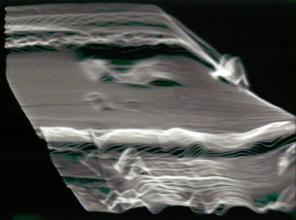Vašulka Mediascape
Woody Vašulka, C-Trend (1974, 9:45)
“In C-Trend, one of Woody Vašulka’s “dialogues with tools,” the video raster, or monitor screen, in controlled by the Rutt-Etra Scan Processor, a scan deflection tool designed by Steve Rutt and Bill Etra in 1973. The camera image being modified is urban traffic whose synchronous sounds are clearly recognizable on the audio track. Two basic modifications of the electronic image are evident: each horizontal line scanned by the electron beam is translated into a live graphic display of voltage, radically reconfiguring the luminance information and the video image, and functioning as a wave form monitor. The shape of the video frame itself, the raster, is also skewed. The deflection coils, which electromagnetically control the electron gun and thus the raster, receive mathematically recoded analog information and reconfigure the normally rectilinear video frame. The “empty spaces” between the altered frames, which appear to drift or roll throughout C-Trend, are the horizontal and vertical blanking intervals between electronic frames.”
Chris Hill, “Program 5,” in Rewind, guide for Surveying the First Decade, Chris Hill, curator, Video Data Bank, Chicago (1996); link: https://www.vdb.org/sites/default/files/2020-04/Rewind_VDB_July2009%202.pdf.
“The work with the scan processor indicates a whole different trend in my understanding of the electronic image … Emphasis has shifted towards a recognition of a time/energy object an its programmable building element – the waveform … We would … make a tool and dialogue with it … We belong to the family of people who would find images like found objects. But it is more complex because we sometimes design the tools, and so do conceptual work as well.”
Woody Vašulka, in catalogue, Beau Fleuve, John Minkowsky and Bruce Jenkins (curators), Media Study/Buffalo (1979); link: https://vasulka.org/archive/4-30d/Bleaufleuve(5107).pdf.
